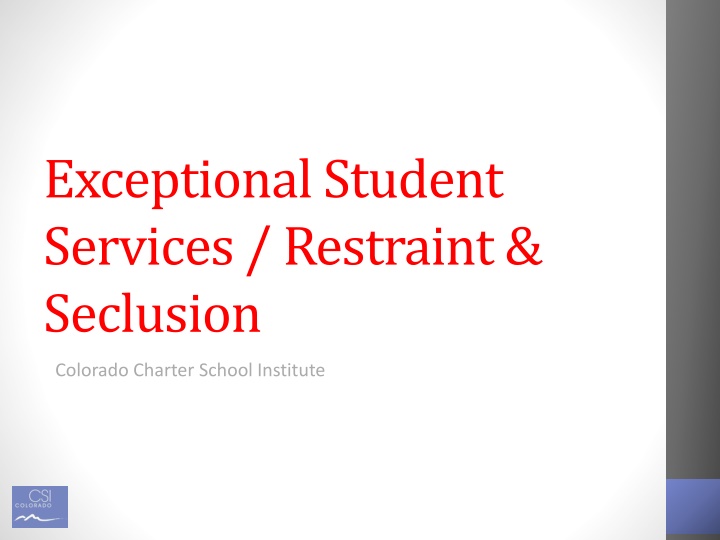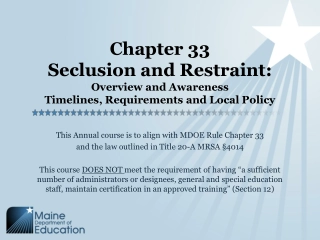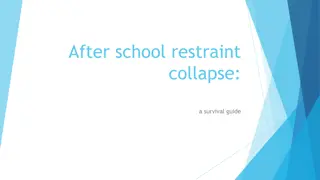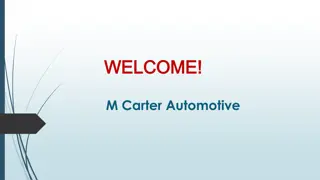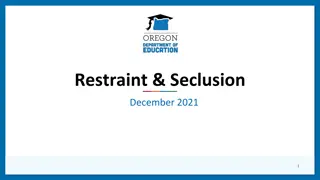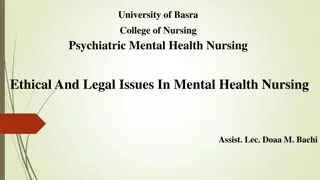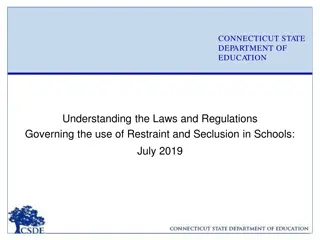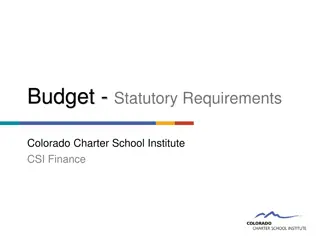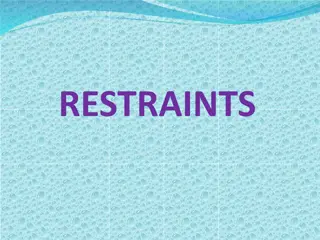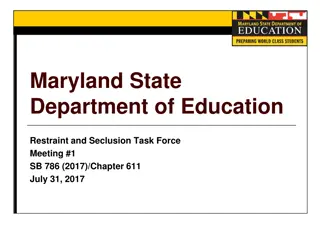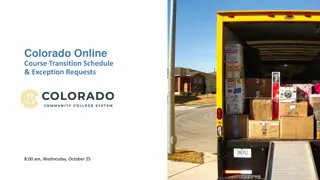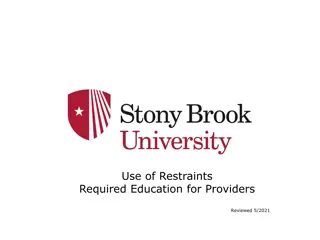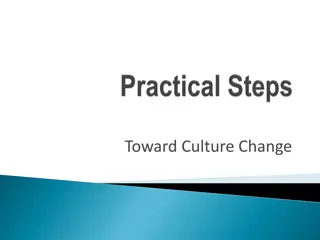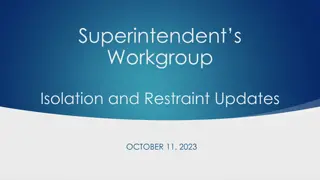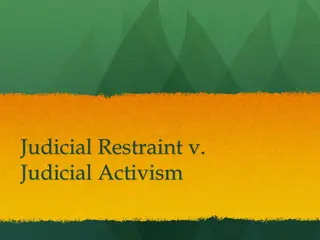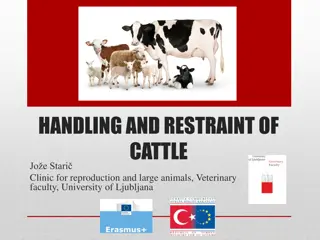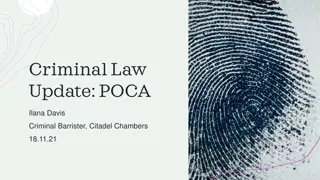Restraint & Seclusion in Colorado Schools
Restraint and seclusion are safety procedures used in response to serious problem behavior in students that could lead to harm. Colorado State Law requires annual training for staff members on these procedures. Restraint can involve physical force, mechanical devices, chemicals, or seclusion. There are three types of restraint: mechanical, chemical, and physical. It's important to note what actions do not constitute restraint, such as protective or comforting holds. Schools are responsible for using restraint only in emergency situations where there is a serious, imminent threat of harm to oneself or others.
Download Presentation

Please find below an Image/Link to download the presentation.
The content on the website is provided AS IS for your information and personal use only. It may not be sold, licensed, or shared on other websites without obtaining consent from the author.If you encounter any issues during the download, it is possible that the publisher has removed the file from their server.
You are allowed to download the files provided on this website for personal or commercial use, subject to the condition that they are used lawfully. All files are the property of their respective owners.
The content on the website is provided AS IS for your information and personal use only. It may not be sold, licensed, or shared on other websites without obtaining consent from the author.
E N D
Presentation Transcript
Exceptional Student Services / Restraint & Seclusion Colorado Charter School Institute
Restraint/Seclusion Defined Restraint & Seclusion refer to safety procedures in which as student is physically held (restraint) or isolated from others (seclusion) in response to serious problem behavior that places the student or others at risk of injury or harm Restraint & Seclusion guidelines apply to all staff regardless of position and all students regardless of age or participation in general or special education
Restraint Law Colorado State Law requires annual training: To review the requirements of Restraint Law as they pertain to individual students To review reporting requirements of Restraint Law as they pertain to state reporting
Restraint Any method or device used to limit freedom of movement, including but not limited to bodily physical force, mechanical devices, chemicals and seclusion. The holding of a student for any length of time with any purpose or intent other than providing safety and/or comfort and support is considered a restraint.
Three Types of Restraint Mechanical : Use of any device (tape, tie-downs) to limit an individual s body movement. Not permitted Chemical: Use of medication to control behavior or restrict a patient s freedom of movement. Not permitted; however, many students may be on medication in schools. Physical: Use of one or more people using their bodies to restrict another s movement. Can be used given certain criteria are met.
Restraint Does NotInclude: Protective, adaptive or positioning supports The holding of a child by one adult for the purposes of calming or comforting the child The holding of an individual for less than five minutes by a staff person for protection of the individual or other persons
School Responsibility An agency may only use restraint in cases of emergency Serious, probable, imminent threat of bodily harm to self or others where there is the present ability to effect such bodily harm. 2.01(1) may exist when a student is destructing property which could lead to harm to the student or to others. 2.00 (5)
If Restraint is likely to be used, training must include: A continuum of prevention techniques Environmental management A continuum of de-escalation techniques Nationally recognized physical management and restraint practices, including techniques that allow restraint in an upright or sitting position Information about the dangers created by prone restraint Methods to explain the use of restraint to the student who is to be restrained and to the individual's family Appropriate documentation and notification procedures AND Re-training at a frequency of at least every two years.
Seclusion Involuntary confinement of a student alone in a room or area, which the student is physically prevented from leaving Time-Out: Time away from positive reinforcement Three kinds of Time-Out, only one is considered seclusion
Three Types of Time-Out Inclusion time-out: Inside the classroom Exclusion time-out :Outside the classroom Seclusion time-out Involuntary confinement of a student alone in a room or area, which the student is physically prevented from leaving
Seclusion Time-Out Unlocked room Regularly monitored by staff Parent permission Typically part of a Behavior Support Plan for a student with or without a disability Documented and reported to IEP (or other appropriate) team, which includes parent & administration
Restraint & Seclusion Frequently Used for Reasons Other Than Emergencies Source: (Ryan, Peterson, Tetreault& Van derHagen, 2007) Restraint Seclusion Leaving Assigned Area 32.6% Noncompliance 31.9% Disrupting Class 11.2% Property Misuse 10.1% Disrespect 4.5% Physical Aggression 2.8% Harassment 2.4% Threats 2.0% Noncompliance 48.4% Leaving Assigned Area 19.4% Disrespect 7.3% Property Misuse 7.3% Disrupting Class 6.5% Physical Aggression 3.2% Threats 3.2% Horseplay 3.2% Harassment 0.8%
Concerns with using Restraint/Seclusion Used as a behavioral treatment or intervention Staff may be injured during attempts to use restraint, risk of harm or injury increases if staff are not adequately trained Inadvertently results in strengthening or reinforcing problematic behavior implemented independent of comprehensive, function based behavioral intervention plan
Avoid the Use of Restraint Promote Positive School Climate/Culture Include comprehensive positive behavior supports throughout the school; teach behavior expectations in all environments, reward positive behaviors/provide clear consistent consequences for negative behaviors. PBIS: Positive Behavior Intervention Support http://www.cde.state.co.us/pbis
Additionally Utilize constructive, non-physical de-escalation & redirection techniques such as those taught in Crisis Prevention Intervention (CPI) Re-structure environmental hotspots (cafeteria, hallways etc) Intentionally teach & practice behavioral expectations in natural environments Utilize individual (within the classroom) and group (across the school) problem solving
Avoid the use of Restraint: Individual Students Develop positive, relevant Behavior Intervention Plans (BIP) that align with the school and/or classroom plan Include how you are going to teach behavioral expectations and replacement behaviors Always include parents Include a Crisis Plan as necessary Ensure all staff are aware of & understand the steps to follow in case of an emergency Progress monitor & tweak the BIP as deemed appropriate by the team
If Restraint if used CDE Restraint Rules Require Have a school team review the circumstances The crisis management section of a student s behavior plan or IEP must address the specific circumstances, procedures and staff involved if there is a possibility that restraint might be used. Be sure all administrators and general education/special education staff are aware that the behavior plan or IEP addresses the specifics of restraint, if it might be used Have parents sign off on the agreed upon plan Review the plan at regular intervals throughout the school year
If Restraint Is Used Document the Incident Verbally notify parents on the same day of incident Submit a written report to school Within 36 hours, send a report to the parent(s) and place a copy in the student s file.
Review Individual Incidents As They Occur School team review of the incident Follow-up meeting(s) with student and family Review documentation of the use of less restrictive alternatives Recommendations for improved procedures IEP team meets to review behavior support plans
Review School Process Annually Annually review the general use of restraints used throughout the school. Complete an analysis of incident reports Provide training based on the needs of staff/students Consider staff to student ratio Consider environmental impacts; physical space, student seating arrangement, noise levels etc Review your schools comprehensive building level response to behavior to include disciplinary & drop- out rates
Parent Complaints If a parent believes that a district has policies that are inconsistent with the restraint rules or that the restraint rules have been violated, the CDE General Grievance process may be used. For information on the CDE grievance process: CDE Grievance Process If a parent of a child with a disability believes that the use of restraint has resulted in or is due to a denial of a free appropriate public education under IDEA, the parent may access the IDEA dispute resolution processes. For information on special education dispute resolution: Special Education Dispute Resolution - See more at: http://www.cde.state.co.us/cdesped/Restraints.asp#sthash.hl 5EeWkF.dpuf
Teachers are protected from individual liability for negligence as long as their actions Occurred within the course and scope of employment duties Were not of a criminal nature Were not willful and wanton
